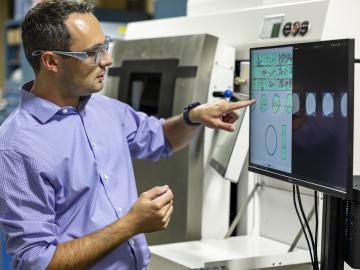
Filter News
Area of Research
- Advanced Manufacturing (4)
- Biological Systems (3)
- Biology and Environment (23)
- Building Technologies (2)
- Chemistry and Physics at Interfaces (4)
- Clean Energy (47)
- Computational Engineering (1)
- Computer Science (1)
- Energy Frontier Research Centers (5)
- Functional Materials for Energy (4)
- Fusion and Fission (5)
- Geographic Information Science and Technology (1)
- Isotope Development and Production (1)
- Isotopes (7)
- Materials (66)
- Materials Characterization (2)
- Materials Synthesis from Atoms to Systems (3)
- Materials Under Extremes (5)
- National Security (13)
- Neutron Science (14)
- Nuclear Science and Technology (3)
- Quantum Condensed Matter (1)
- Reactor Technology (1)
- Supercomputing (30)
- Transportation Systems (2)
News Type
Date
News Topics
- 3-D Printing/Advanced Manufacturing (10)
- Advanced Reactors (2)
- Artificial Intelligence (12)
- Big Data (4)
- Bioenergy (7)
- Biology (10)
- Biomedical (4)
- Biotechnology (3)
- Buildings (5)
- Chemical Sciences (11)
- Clean Water (2)
- Climate Change (15)
- Composites (2)
- Computer Science (10)
- Coronavirus (3)
- Critical Materials (3)
- Cybersecurity (5)
- Decarbonization (11)
- Education (3)
- Energy Storage (13)
- Environment (17)
- Exascale Computing (4)
- Frontier (6)
- Fusion (3)
- Grid (5)
- High-Performance Computing (16)
- Hydropower (2)
- Isotopes (6)
- Machine Learning (7)
- Materials (32)
- Materials Science (9)
- Mathematics (2)
- Mercury (1)
- Microscopy (5)
- Molten Salt (1)
- Nanotechnology (3)
- National Security (10)
- Net Zero (2)
- Neutron Science (10)
- Nuclear Energy (7)
- Partnerships (18)
- Physics (6)
- Polymers (2)
- Quantum Computing (4)
- Quantum Science (4)
- Renewable Energy (1)
- Security (3)
- Simulation (10)
- Space Exploration (1)
- Summit (2)
- Sustainable Energy (3)
- Transportation (7)
Media Contacts

Guided by machine learning, chemists at ORNL designed a record-setting carbonaceous supercapacitor material that stores four times more energy than the best commercial material.

Seven scientists from ORNL have been named among the world’s most influential researchers on the 2023 Highly Cited Researchers list, produced by Clarivate, a data analytics firm that specializes in scientific and academic research.

A team of researchers associated with the Quantum Science Center headquartered at the Department of Energy's Oak Ridge National Laboratory has confirmed the presence of quantum spin liquid behavior in a new material with a triangular lattice, KYbSe2.

While completing his undergraduate studies in the Philippines, atmospheric chemist Christian Salvador caught a glimpse of the horizon. What he saw concerned him: a thin, black line hovering above the city.

The Department of Energy’s Office of Science has allocated supercomputer access to a record-breaking 75 computational science projects for 2024 through its Innovative and Novel Computational Impact on Theory and Experiment, or INCITE, program. DOE is awarding 60% of the available time on the leadership-class supercomputers at DOE’s Argonne and Oak Ridge National Laboratories to accelerate discovery and innovation.

Researchers at ORNL have been leading a project to understand how a high-altitude electromagnetic pulse, or EMP, could threaten power plants.

Scientists at ORNL used their expertise in quantum biology, artificial intelligence and bioengineering to improve how CRISPR Cas9 genome editing tools work on organisms like microbes that can be modified to produce renewable fuels and chemicals.

Raina Setzer knows the work she does matters. That’s because she’s already seen it from the other side. Setzer, a radiochemical processing technician in Oak Ridge National Laboratory’s Isotope Processing and Manufacturing Division, joined the lab in June 2023.

Walters is working with a team of geographers, linguists, economists, data scientists and software engineers to apply cultural knowledge and patterns to open-source data in an effort to document and report patterns of human movement through previously unstudied spaces.

Researchers at the Department of Energy’s Oak Ridge National Laboratory have improved flaw detection to increase confidence in metal parts that are 3D-printed using laser powder bed fusion.


